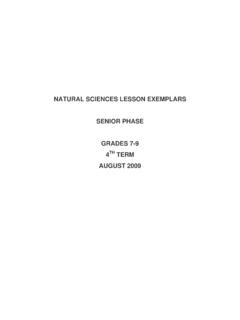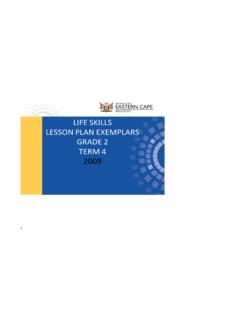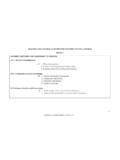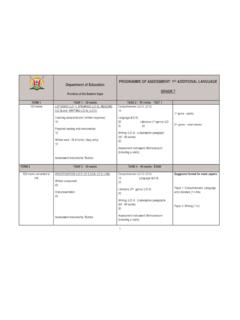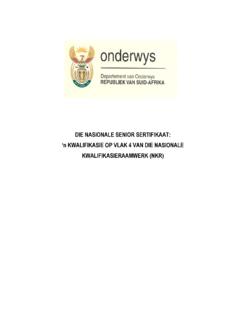Transcription of PROVINCIAL ASSESSMENT GUIDELINES LIFE ORIENTATION …
1 Province of the Eastern Cape DEPARTMENT OF EDUCATION ISEBE LEZEMFUNDO DEPARTMENT VAN ONDERWYS _____ PROVINCIAL ASSESSMENT GUIDELINES life ORIENTATION 2007 1 PREFACE The Eastern Cape Department of Education, Curriculum Chief Directorate in collaboration with the district curriculum personnel, developed this document to support teachers in planning, teaching and ASSESSMENT for effective implementation of the National Curriculum Statement in the GET Band. This document contains exemplars of work schedules, lesson plans and ASSESSMENT tasks. It is prepared with the intention to give necessary guidance for planning of teaching , learning and ASSESSMENT . This document must be used in collaboration with the following documents: National Curriculum Statement, NCS Teacher Guide, National and PROVINCIAL ASSESSMENT GUIDELINES , Content Framework for Senior Phase(2007) and Physical Education in life ORIENTATION (2008).
2 This is a guide to assist teachers in planning, it is not cast on stone. Critical engagement with the document is encouraged. Inputs, suggestions and recommendations that will improve this document are most welcome. 2 TABLE OF CONTENTS PREFACE 1 TABLE OF CONTENTS 2 INTRMEDIATE PHASE WORKSCHEDULES: GRADE 4 WORKSCHEDULE 3-9 GRADE 5 WORKSCHEDULE 10-15 GRADE 6 WORKSCHEDULE 16-22 SENIOR PHASE WORK SCHEDULE GRADE 7 WORKSCHEDULE 23-28 GRADE 8 WORKSCHEDULE 28-33 GRADE 9 WORKSCHEDULE 34-38 LESSON PLANS GRADE 4 LESSON PLANS 39-43 GRADE 5 LESSON PLANS 44-47 GRADE 6 LESSON PLANS 48-51 GRADE 7 LESSON PLANS 52-58 GRADE 8 LESSON PLANS 58-61 GRADE 9 LESSON PLANS 62-65 3 TABLE OF CONTENTS CONTENT PAGE PREFACE 1 ACKNOWLEDGEMENT 2 TABLE OF CONTENTS 3 1.
3 INTRODUCTION 4 NATURE OF ASSESSMENT IN LO 4 3. CONTINUOS ASSESSMENT (CASS) 4 4. PLANNING FORMAL ASSESSMENT 4 5. FORMAL ASSESSMENT TASKS (IP) 5 6. FORMAL ASSESSMENT TASKS(SP) 8 7. MODERATION 11 8. LEVELS OF MODERATION 11 9. MODUS OPERANDI 12 10. ANNEXURES 15 4 1. INTRODUCTION This document serves to highlight issues on ASSESSMENT in life ORIENTATION in the Intermediate and Senior Phase. Emphasis is placed on school based ASSESSMENT . The document should be read/ utilized in conjunction with the life ORIENTATION National ASSESSMENT guideline document. The purpose of this document therefore, is not to repeat any part of the national ASSESSMENT GUIDELINES which are based on the ASSESSMENT policy of February 2007 but merely to expand on issues not clearly stated yet crucial for micro planning of learner ASSESSMENT .
4 2. THE NATURE OF ASSESSMENT IN life ORIENTATION life ORIENTATION is predominantly a practical Learning Area and should be approached / addressed as such. ASSESSMENT in the NCS should always be seen as integral to planning, teaching and learning. The core of life ORIENTATION Learning Outcomes. 5 life ORIENTATION deals with the holistic development of the learner. The central focus is on the development of self-in-society. life ORIENTATION equips the learner with the skills, knowledge and values which are captured in the ASSESSMENT standards within each Learning Outcome. This would enable the learner to: Make informed decisions regarding personal, community and environmental health. Demonstrate an understanding and a commitment to constitutional rights and responsibilities and to show an understanding of diverse cultures and religions.
5 Use acquired life skills to achieve and extend personal potential to respond effectively to challenges in his/her world. Demonstrate an understanding of, and participate in, activities that promote movement and physical development for a healthy life style. Make informed decisions about further studies and future career choices (in Senior Phase.) These five Learning Outcomes of life ORIENTATION equip learners with real life experiences in managing their own life in a well-informed and responsible manner. The approach to ASSESSMENT should therefore be practical so that learners develop through experience, by acquiring knowledge, life skills, and moral values necessary for living in a democratic and changing society. 3. CONTINUOUS ASSESSMENT (CASS) Outcomes Based ASSESSMENT (OBA) requires the use of appropriate tools that assess learner achievement and encourage lifelong learning skills.
6 Continuous ASSESSMENT is considered the best model to assess outcomes of learning and teaching throughout the system and ensures development in the learning and teaching process. CASS should not be interpreted merely as the accumulation of a series of traditional test results, but it must be used to support the learner s needs and to feed back into teaching and learning. CASS is informal and formal, but it is formal tasks or activities that are recorded for purposes of progression and promotion. Informal ASSESSMENT is very important; therefore it should be used to inform formal ASSESSMENT . It is used for formative purposes to support teachers in their daily planning and to assist them in making professional judgment on learner performance. Informal ASSESSMENT should be recorded as supportive evidence.
7 4. PLANNING FORMAL ASSESSMENT 6 An important part of planning for ASSESSMENT is indicated in the Learning Programme and detailed in the Work Schedule Level, what type of ASSESSMENT will be used, and decide on the range of tasks to be assessed. Each Learning Area should have an annual ASSESSMENT Plan which is derived from the Work Schedules and indicate the details of ASSESSMENT per grade. These will inform the School ASSESSMENT Programme which is a compilation of all the grade ASSESSMENT plans. Schools are at liberty to begin with a focus area of their choice. life ORIENTATION should have four formal tasks per year in grades 4-8, and three in grade 9 as the CTA will be administered during the fourth term. In Grade 9 three formal ASSESSMENT tasks should be completed for the first three terms.
8 Each of these ASSESSMENT tasks addresses Lo I, 2, 3, 5 and make up 20%. 5% is allocated to the Physical Education Task to give a total of 25% per term. An ASSESSMENT task refers to an ASSESSMENT activity that is designed to assess a range of skills and competencies. This should be a range of activities that will build up to the following:- Design and make Oral presentation Practical demonstration Project An action research For more examples refer to page 28 of National ASSESSMENT GUIDELINES . Practical participation: Physical Education Task This task is made up of movement activities and should focus predominantly on Learning Outcome 4. It extends across the four terms of the school year. Basic skills like walking, running, jumping, sliding, gymnastics, athletics, water activities, water safety, rhythmic movement national or traditional dances, fitness, and dance form part of these tasks.
9 In the senior phase orienteering and outdoor activities are added. (Refer to p4 of National ASSESSMENT GUIDELINES for life ORIENTATION for more information on this). FORMAL ASSESSMENT TASKS 5. EXAMPLE OF AN INTERMEDIATE PHASE FORMAL ASSESSMENT TASK 7(GRADE 6) LEARNING OUTCOME 1 (WEIGHT 20%) HEALTH PROMOTION AS 2: Participates in a problem-solving activity to address an environmental health issue to formulate environmentally sound choices and / or actions. AS 3 Explains causes of communicable diseases (including HIV/AIDS) and available cures, and evaluates prevention strategies, in relation to community norms and personal values. LO 2: SOCIAL DEVELOPMENT AS 2: Discusses and evaluates the significance of a nation-building programme associated with a national day. LO4: PHYSICAL DEVELOPMENT AS1: Applies relevant concepts in a variety of striking and fielding games.
10 LO3: PERSONAL DEVELOPMENT AS3: Demonstrates compassion by caring for people and animals. Identify ONE environmental health issue. Explain the: Causes Available cures and Prevention strategies What are the norms (expectations of society) in relation to the above? The following ASSESSMENT forms can also be used: Design and make posters \ collage to be used in an awareness campaign. Oral presentations can be done by groups based on their chosen topics. SUGGESTED ACTIVITIES FOR THE ASSESSMENT TASK (All the tasks to reflect Knowledge, Skills and Values) Step 1(One week) Identify communicable diseases and choose one 8(Baseline ASSESSMENT ) Step 2(Two weeks) Research on the chosen topic under the following headings:- i) Causes ii) Available cures iii) Prevention strategies in relation to society norms and personal values.
